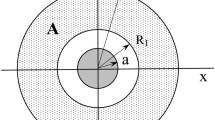Abstract
A mathematical method is proposed for calculating residual stresses from hole drilling electronic speckle pattern interferometry (ESPI) data, independent of rigid-body motions. Even though the signal-to-noise ratio of typical ESPI data is modest, the method achieves good computational stability by averaging a large amount of data. It does this without excessive numerical effort by exploiting known trigonometric relationships among the data. The resulting stress calculations are very rapid, and are well suited for future application to non-uniform stress measurements.
Similar content being viewed by others
References
Mathar, J., “Determination of Initial Stresses by Measuring the Deformations Around Drilled Holes,”Transactions of the ASME, Iron Steel,56 (2),249–254 (1934).
Soete, W. andVancrombrugge, R. “An Industrial Method for the Determination of Residual Stresses,”Proceedings of SESA,8 (1),17–28 (1950).
Rendler, N.J. andVigness, I., “Hole Drilling Strain-gage Method of Measuring Residual Stresses,” EXPERIMENTAL MECHANICS,6 (12),577–586 (1966).
American Society for Testing and Materials, “Standard Test Method for Determining Residual Stresses by the Hole Drilling Strain-Gage Method,”ASTM E837-01.American Society for Testing and Materials, West Conshohocken, PA (2001).
Butters, J.N. andLeendertz, J.A., “Holographic and Video Techniques Applied to Engineering Measurements,”Journal of Measurement and Control,4 (12),349–354 (1971).
Macovski, A., Ramsey, S.D., andSchaefer, L.F., “Time-lapse Interferometry and Contouring Using Television Systems,”Applied Optics,10,2722–2727 (1971).
Nelson, D.V. andMcCrickerd, J.T., “Residual-stress Determination Through Combined Use of Holographic Interferometry and Blind-Hole Drilling,” EXPERIMENTAL MECHANICS,26 (4),371–378 (1986).
Makino, A. andNelson, D., “Residual-stress Determination by Singleaxis Holographic Interferometry and Hole Drilling—Part I: Theory,” EXPERIMENTAL MECHANICS,34 (1),66–78 (1994).
Schmitt, D.R. andHunt, R.W., “Inversion of Speckle Interferometer Fringes for Hole Drilling Residual Stress Determinations,” EXPERIMENTAL MECHANICS,34 (1),129–137 (2000).
Focht, G. andSchiffner, K., “Determination of Residual Stresses by an Optical Correlative Hole Drilling Method,” EXPERIMENTAL MECHANICS,43 (1),97–104 (2003).
Steinzig, M. andPonslet, E., “Residual Stress Measurement using the Hole Drilling Method and Laser Speckle Interferometry: Part 1,”Experimental Techniques,27 (3),43–46 (2003).
Jones, R. andWykes, C., Holographic and Speckle Interferometry, 2nd edition, Cambridge University Press, Cambridge (1989).
Cloud, G.L., Optical Methods of Engineering Analysis, Cambridge University Press, Cambridge (1995).
Schajer, G.S., “Measurement of Non-uniform Residual Stresses Using the Hole Drilling Method. Part I—Stress Calculation Procedures,”Journal of Engineering Materials and Technology,110 (4),338–343 (1988).
Zienkiewicz, O.C., The Finite Element Method, 3rd edition, Chapter 15, McGraw-Hill, New York (1977).
Rumzan, I. andSchmitt, D.R., “Three-dimensional Stress-relief Displacements from Blind-hole Drilling: A Parametric Description,” EXPERIMENTAL MECHANICS,43 (1),52–60 (2003).
Dahlquist, G., Björk, Å., andAnderson, N., Numerical Methods, Chapter 4, Prentice-Hall, Englewood Cliffs, NJ (1974).
Steinzig, M., Hayman, G.J., and Prime, M.B., “Verification of a Technique for Holographic Residual Stress Measurement, Residual Stress Measurement and General Non-destructive Evaluation, PVP Vol. 429 D. E. Bray, editor, ASME Pressure Vessels and Piping Conference, Atlanta, GA, July 23–26 (2001).
Author information
Authors and Affiliations
Rights and permissions
About this article
Cite this article
Schajer, G.S., Steinzig, M. Full-field calculation of hole drilling residual stresses from electronic speckle pattern interferometry data. Experimental Mechanics 45, 526–532 (2005). https://doi.org/10.1007/BF02427906
Received:
Revised:
Issue Date:
DOI: https://doi.org/10.1007/BF02427906




